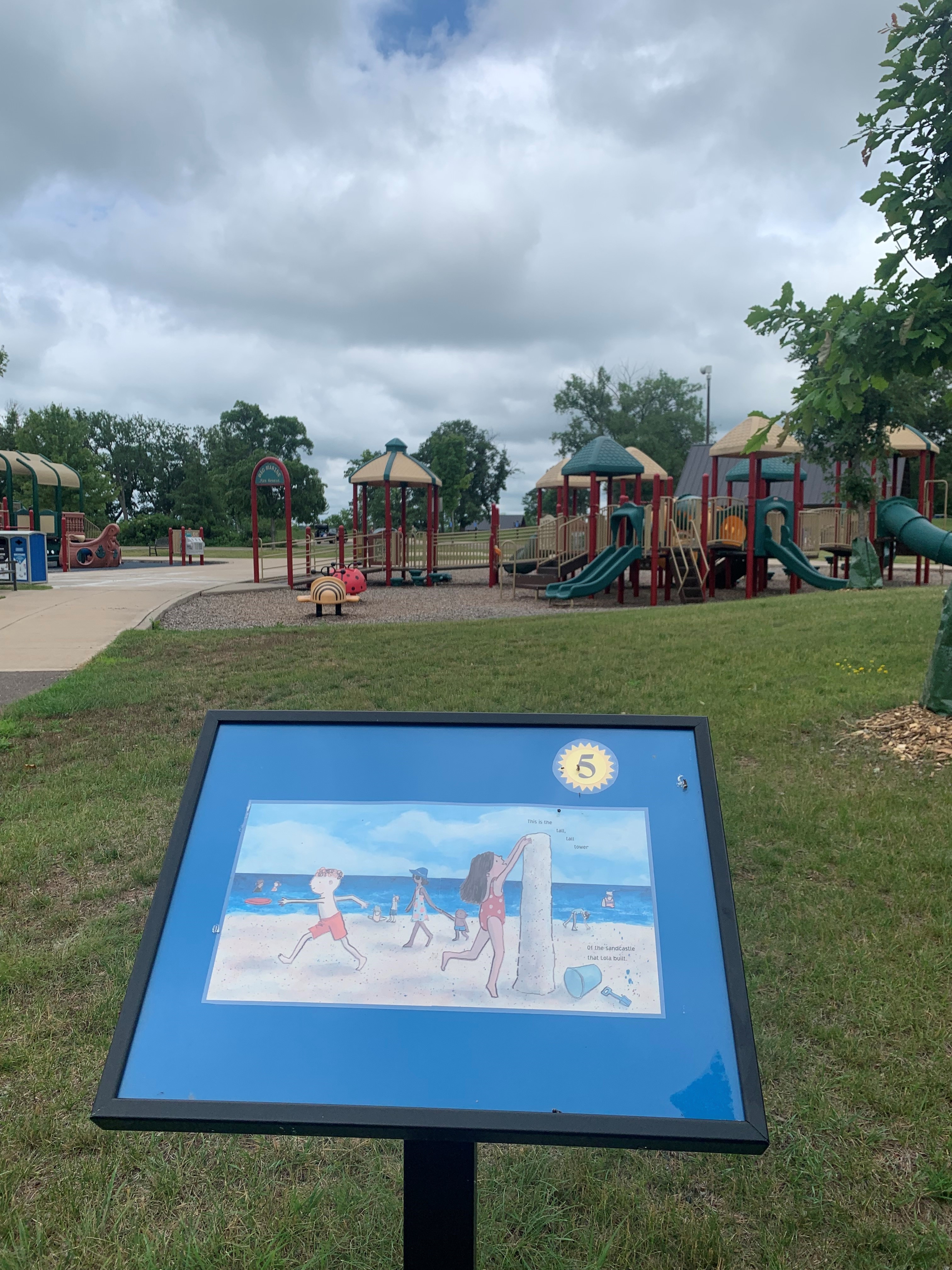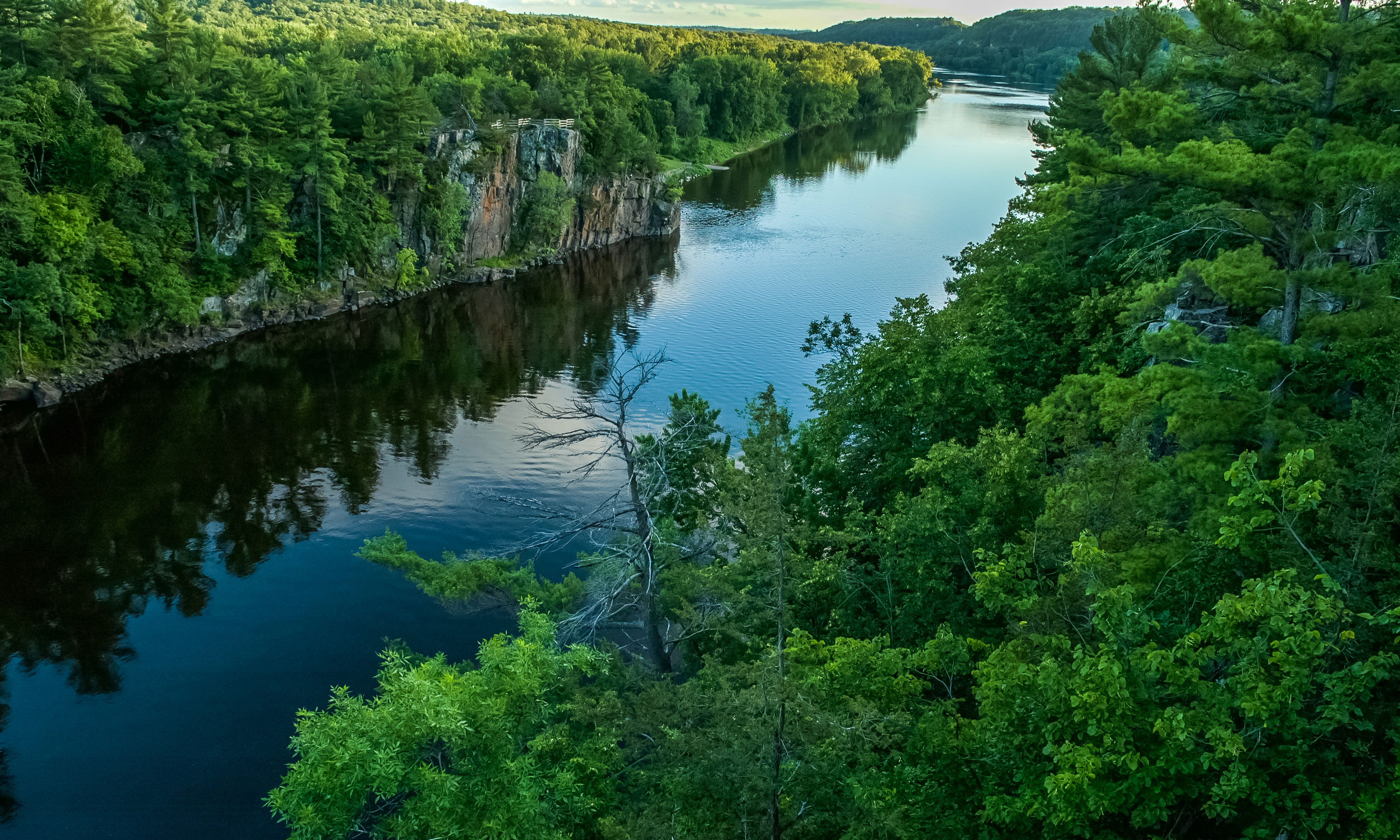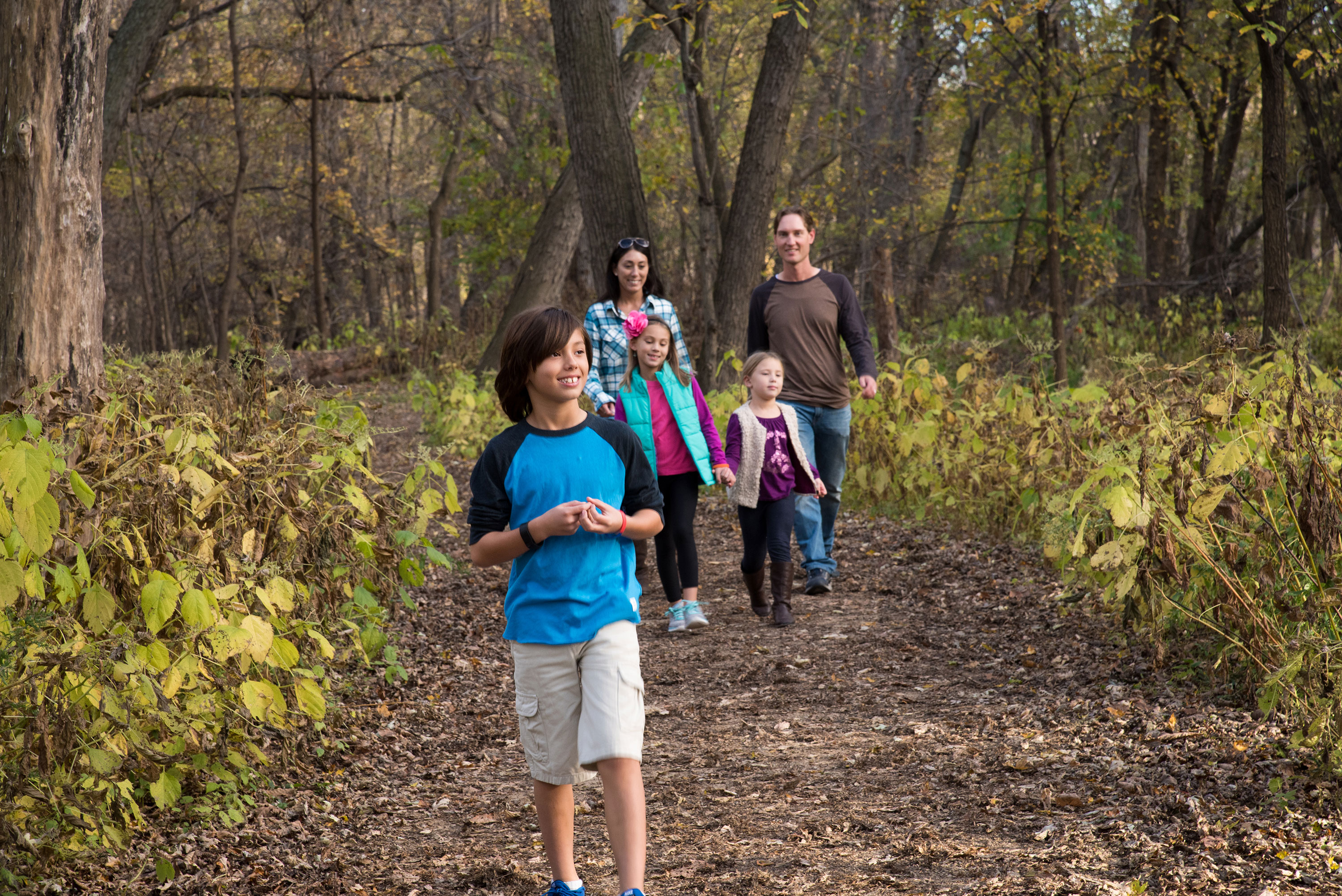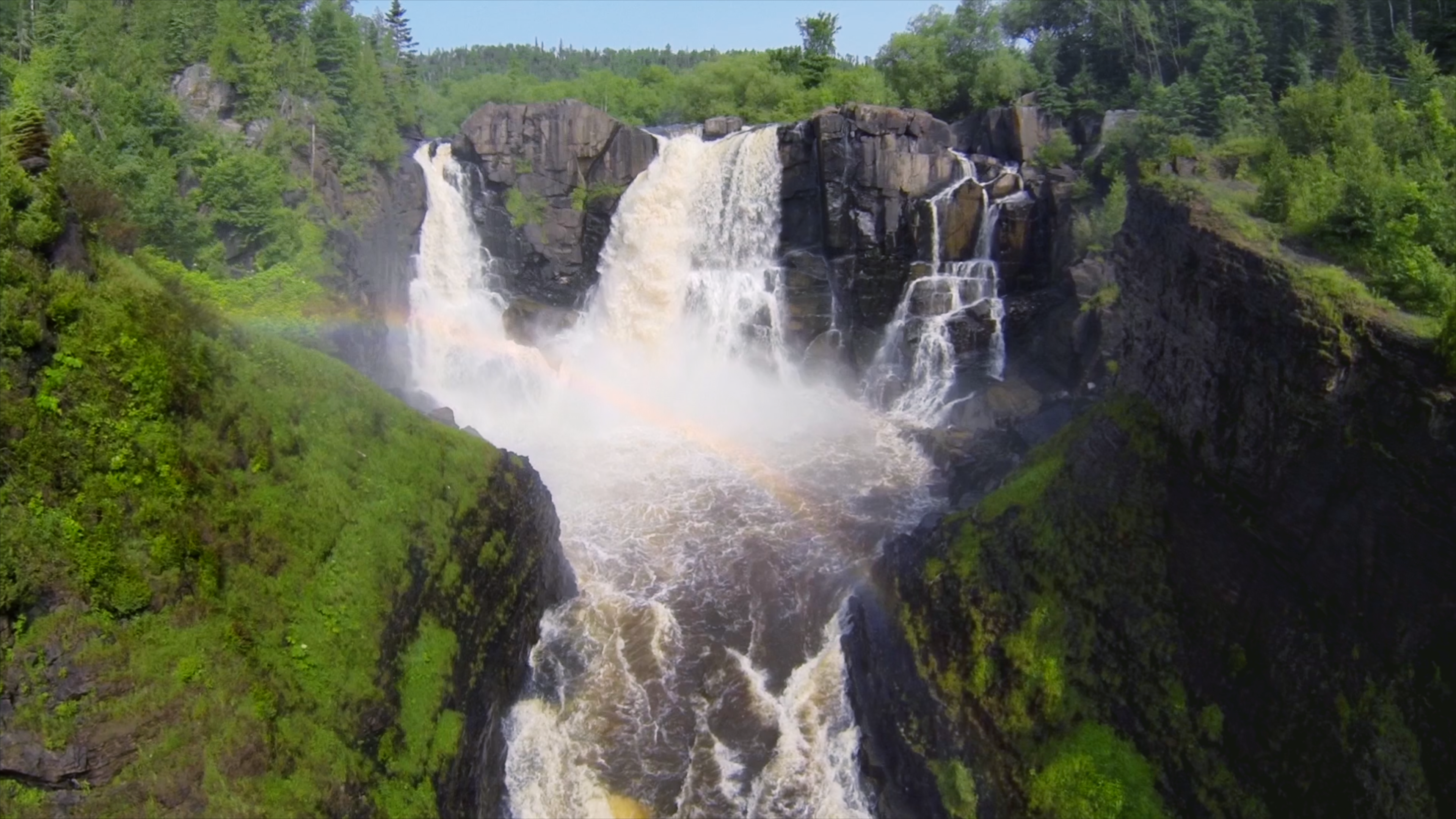
Where to Hike With Kids in Minnesota
Where to Hike With Kids in Minnesota
By Amy Barrett
An essential part of any road trip, as any adult in the front seat knows, is stopping once in a while to give any restless kids (and pets) in the backseat a break. Every 100 miles or so, getting out of the car and into nature can be just what the doctor, or the driver, ordered.
Luckily, Minnesota offers an abundance of exceptional trails on which to stretch legs of any length. Here are just some of them.
MINNEAPOLIS-ST. PAUL AREA
-
Story Adventure Trail, Big Marine Park Reserve

The Story Adventure Trail at Big Marine Park Reserve combines hiking with books.
Story Adventure Trail, Big Marine Park ReservePages of a children’s book are posted along the Story Adventure Trail at Big Marine Park Reserve near Stillwater, so little ones have to keep hiking to find out what happens next. Older kids can read to younger ones or everyone can take turns. The trail is about a half-mile loop, and the story changes every few months.
-
Interpretive Trail Loop, Afton State Park

The St. Croix National Scenic Riverway encompasses some of the most scenic and least developed country in the Upper Midwest
Interpretive Trail Loop, Afton State ParkExplore a restored prairie on this quarter-mile trail just south of the visitor center at Afton State Park. Interpretive signs describe the plants and animals that are adapted to and live in Minnesota’s prairie habitats. Extend your hike by following a paved trail along a bluff overlooking the St. Croix River, designated by the National Park Service as a National Scenic Riverway.
-
Pike Island, Fort Snelling State Park

Wander the trails at Fort Snelling State Park / Minnesota DNR
Pike Island, Fort Snelling State ParkJust across Highway 5 from MSP International Airport, where you might not expect a state park, you'll find Fort Snelling State Park. Turkeys and deer will frequently greet you upon your arrival, and you may spot a few more as you proceed to the visitor center, where the trail to Pike Island begins. The island has a choice of one-, two- and three-mile loop trails. The three-mile trail will lead you along the shoreline to the confluence of the Mississippi and Minnesota rivers. In the summertime, you can picnic and swim at the park’s beach. In the winter, you can warm up by the fireplace in the visitor center.
NORTHWEST MINNESOTA
-
Mississippi Headwaters, Itasca State Park

Cross the headwaters of the Mighty Mississippi at Itasca State Park. / Kvidt Creative
Mississippi Headwaters, Itasca State ParkOne of the quintessential Minnesota experiences – right up there with hearing a loon call and catching a snowflake on your tongue – is crossing the Mississippi (the world’s third longest river) near its source at Itasca State Park in Park Rapids. Start your half-mile hike at the Mary Gibbs Mississippi Headwaters Center, pose for a family photo in front of the iconic log monument, then kick off your shoes and wade to the other side.
Another great option for families with young children is the Maadaadizi Trail, which starts behind the Jacob V. Brower Visitor Center. It’s short, flat enough for strollers and will engulf you in the Northwoods fragrance of pine trees.
-
Pollinator Trail, Buffalo River State Park

Prairie grasses at Buffalo River State Park
Pollinator Trail, Buffalo River State ParkThis half-mile loop trail (also known as the Muskoda Trail) adjoining the campground at Buffalo River State Park is a haven for bees, butterflies (including Minnesota's state butterfly, the monarch) and other pollinators. Look for them on colorful flowers along the trail. Buffalo River is one of 10 Minnesota state parks that have recently installed educational pollinator plantings and exhibits with information about how to help pollinators by planting milkweed and wildflowers where you live.
-
Bog Walk, Lake Bemidji State Park

Lake Bemidji State Park bog walk / Minnesota DNR
Bog Walk, Lake Bemidji State ParkTravel to Lake Bemidji State Park in late June or early July to see Minnesota’s beautiful state flower, the pink and white showy lady’s slipper, along with a variety of other eye-catching (and even fly-catching!) plants. Interpretive signs will help you spot the insect-eating sundew and pitcher plants – as well as lady’s slippers galore – along a quarter-mile boardwalk that zig-zags through the park’s spruce/tamarack bog.
NORTHEAST MINNESOTA
-
High Falls, Grand Portage State Park

Minnesota's highest waterfall awaits hikers at Grand Portage State Park.
High Falls, Grand Portage State ParkMinnesota’s highest waterfall awaits discovery at Grand Portage State Park on the Canadian border. Stop in the visitor center to see exhibits about the Anishinaabe people, then head out the back door to a half-mile paved, stroller- and wheelchair-friendly trail. It leads to High Falls, a magnificent 120-foot waterfall, surrounded by several viewing platforms, where you can soak in the view, take photos and, often, see rainbows.
-
Swinging Bridge, Jay Cooke State Park

Hike across the suspension bridge above the St. Louis River at Jay Cooke State Park
Swinging Bridge, Jay Cooke State ParkIt doesn’t swing or squeak as much as it once did, but this historic bridge over the raging St. Louis River is still a big draw, for kids and adults alike at Jay Cooke State Park. Go across and back, then take the Civilian Conservation Corps (C.C.C.) Trail west along the river behind the historic River Inn Interpretive Center. In a half mile, you can cross the road to continue the 1.8-mile loop trail or turn around and go back the way you came. On chilly days, warm up by the fireplace in the River Inn.
CENTRAL MINNESOTA
-
Trail Through Time, Mille Lacs Kathio State Park

Enjoy a panoramic view from atop the fire tower at Mille Lacs Kathio State Park. / GearJunkie
Trail Through Time, Mille Lacs Kathio State ParkVisit the sites of ancient Native American villages as you follow this mostly flat, one-mile loop trail through the forest at Mille Lacs Kathio State Park, a National Historic Landmark in Onamia. The half-mile Touch the Earth Trail, a self-guided interpretive trail with a boardwalk through a bog, is also well-suited for hiking with kids. If you come in late September or early October, you can climb to the top of the park’s 100-foot fire tower for a spectacular view of the surrounding area.
-
Mount Tom, Sibley State Park
Mount Tom overlook in Sibley State Park / Jessica Brouliette
Mount Tom, Sibley State ParkSibley State Park in New London has something for everyone. While teens trek to the top of Mount Tom for one of the best views in Central Minnesota (3.3 miles roundtrip), younger hikers can explore the mostly flat Pondview Trail, a 0.7-mile loop near the visitor center. On hot days, all ages will enjoy cooling off together at the park’s popular swimming beach.
SOUTHERN MINNESOTA
-
Loon Island, Lake Shetek State Park

Hike around Loon Island and you may see Minnesota's state bird at Lake Shetek State Park. / Travis Novitsky
Loon Island, Lake Shetek State ParkWatch and listen for loons (the state bird) and a variety of other waterfowl as you cross the causeway to Loon Island at Lake Shetek State Park in Currie. The mile-long, mostly flat trail circles the island, where you can expect songbirds to serenade you as you hike, especially in the spring. “Shetek” is an Ojibwe word for pelican, one of the bigger birds you might see at the park, along with herons, cormorants and eagles. The ideal time to take this hike is during spring or fall migration. Pack your binoculars and a bird book to help with identification or stop in at the park office and borrow one of their birding kits before you set off.
-
Quarry Hill Nature Center, Rochester

Quarry Hill Nature Center / Experience Rochester
Quarry Hill Nature Center, RochesterLittle ones sometimes don’t look quickly enough to see a deer or a turkey along a hiking trail before they run for cover, but the nice thing about hiking at a nature center is that there are often live animal exhibits. Inside the Exploration Hall at Quarry Hill Nature Center in Rochester, for example, you can see 35 species of live animals and seven kinds of Minnesota fish. That’s in addition to whatever you might see outside on more than eight miles of trails for all ages and abilities. Paved “family trails” lead from the Exploration Hall to two playgrounds, .7 miles in one direction and .9 miles in the other.
MORE WAYS TO HIKE

Many state parks loan GPS units to visitors who want to try geocaching. / MN DNR
Geocaching
If you worry that your kids (or – face it – your spouse) might not like the sound of “hiking,” try pitching the idea of going geocaching instead. Geocaching involves using a GPS device to hunt for “caches” of hidden treasure. The cache is typically a weather-tight metal or plastic container filled with little toys and tokens. You can find the coordinates (longitude and latitude) of caches hidden near you at geocaching.com. Plug them into your GPS, and it will point you in the direction of the cache. Don’t have your own GPS? Many state parks loan them out for free and provide instruction at geocaching events.

Don't stop hiking when it snows; start snowshoeing!
Snowshoeing
Once it snows, go for a snowshoe hike. Many state parks rent snowshoes in kid and adult sizes ($6/day), and it’s fun to tromp around in them, looking for animal tracks and other signs of nature. Dress in layers, because you can work up a sweat in a hurry with all that leg lifting. Snowshoers need not stay on the trails. It's OK to go anywhere except on groomed cross-country ski trails.

Sunset on the Superior Hiking Trail / Alyssa Hei
KNOW BEFORE YOU GO
- A vehicle permit is required to enter Minnesota state parks. Save time by ordering one online before you arrive at the park.
- For comfort and safety on the trail, be sure everyone has appropriate footwear (tennis shoes, not flip-flops).
- Bring a water bottle for each hiker as well as plenty of sunscreen, bug spray and snacks.
- Pick up a paper map at the park office or load a GeoPDF map before you leave (don’t rely on your phone to navigate because cell and Internet service may not be available in the woods).
- The accessible trails at Minnesota state parks are stroller friendly as well as wheelchair friendly.
- Some Minnesota state parks have all-terrain electric wheelchairs for use on unpaved trails.
- If your dog will be hiking with you, keep it on a leash and clean up after it.
- Don't pick wildflowers or otherwise disturb the landscape. "Take only photos, leave only footprints."













